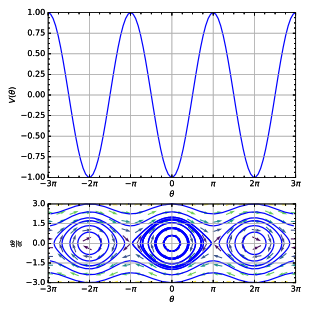
Back صورة الطور Arabic Retrat de fase Catalan Phasenporträt German Retrato de fase Spanish نگاره فاز Persian Portrait de phase French Ritratto di fase Italian Fazinis portretas Lithuanian Diagram fazowy (fizyka) Polish Retrato de fase Portuguese
| Differential equations |
|---|
| Scope |
| Classification |
| Solution |
| People |


In mathematics, a phase portrait is a geometric representation of the orbits of a dynamical system in the phase plane. Each set of initial conditions is represented by a different point or curve.
Phase portraits are an invaluable tool in studying dynamical systems. They consist of a plot of typical trajectories in the phase space. This reveals information such as whether an attractor, a repellor or limit cycle is present for the chosen parameter value. The concept of topological equivalence is important in classifying the behaviour of systems by specifying when two different phase portraits represent the same qualitative dynamic behavior. An attractor is a stable point which is also called a "sink". The repeller is considered as an unstable point, which is also known as a "source".
A phase portrait graph of a dynamical system depicts the system's trajectories (with arrows) and stable steady states (with dots) and unstable steady states (with circles) in a phase space. The axes are of state variables.
© MMXXIII Rich X Search. We shall prevail. All rights reserved. Rich X Search
